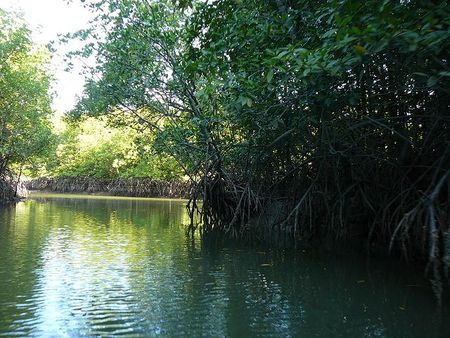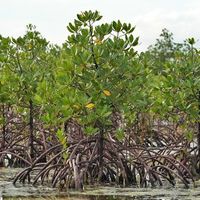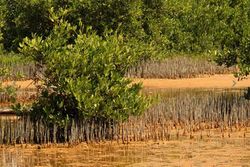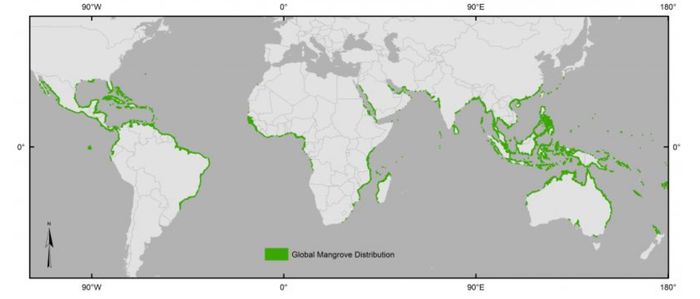Mangroves
This article describes the habitat of the mangrove forests. It is one of the subcategories within the section dealing with the biodiversity of marine habitats and ecosystems. It provides an overview of the characteristics, distribution, biota, functioning and adaptation to habitat conditions. An introduction is given to management aspects, discussing threats, conservation and rehabilitation of mangrove forests.
Contents
- 1 Introduction
- 2 Requirements for development
- 3 Distribution
- 4 Functioning and adaptations
- 5 Biota
- 6 Coastal protection
- 7 Other ecosystem services
- 8 Threats
- 9 Mangrove loss
- 10 Community participation in mangrove management
- 11 Mangrove restoration and rehabilitation
- 12 Further reading
- 13 Related articles
- 14 External links
- 15 References
Introduction
Mangroves are the only trees that are capable of thriving in salt water. They form unique intertidal forests at the edge of land and sea, see Fig. 1. They are represented on all continents with tropical and subtropical coasts, i.e. North and South America, Africa and Middle-East, Asia and Oceania (incl. Australia). [1]
Mangrove forests or mangals are a type of intertidal wetland ecosystems. The word mangrove is derived from the Portugese word mangue which means “tree” and the English word grove which is used for trees and shrubs that are found in shallow, sandy or muddy areas (Karleskint, 1998[2]). They replace salt marshes in tropical and subtropical regions. They are salt-tolerant forested wetlands at the interface between the terrestrial landscape and the marine environment. The dominant vegetation are several species of mangrove: woody trees and shrubs with a thick, partially exposed network of roots that grow down from the branches into the water and sediment. They settle where there is little wave action and where muddy sediments accumulate. While growing, mangal forests further reduce waves and increase sedimentation. Wave energy reduction can be greater than 50% on average and increases with increasing offshore wave heights (Horstman et al., 2014[3]). Mangals therefore fulfill an important coastal protection function. Mangroves are frequently associated with saline lagoons and are regularly found on protected sides of islands, atolls and tropical estuaries (Karleskint, 1998[2]).
Requirements for development
Requirements for the development of mangroves are:
- Average temperature of the coldest month higher than 20°C; the seasonal temperature range should not exceed 5°C. They are not resistant to freezing.
- A fine-grained substrate. Exceptions are the development of mangroves on corals, as for example in Papua New Guinea and Kenya.
- Shores must be free of strong wave action and strong tidal currents.
- Saline water; they are facultative halophytes.
- Deposition of sediments by small-moderate waves and tides.
These different requirements result in complex zonation patterns. Red mangroves (e.g. Rhizophora apiculata, Rhizophora stylosa, Rhizophora mucronata) and the grey mangrove Avicennia marina are often located close to the water's edge, where frequent tidal flooding occurs. Areas that receive shallow flooding during high tide are home to mangrove species such as Bruguiera gymnorhiza. The upper tidal limit (spring tide) of the mangroves is occupied by mangrove species such as Xylocarpus granatum, white mangroves and buttonwood. The buttonwood is not really a mangrove species, but a transitional species between mangrove and terrestrial vegetation.
Distribution
The area covered by mangroves worldwide is estimated at almost 150,000 km2 [4][5]. The distribution, density and species composition are determined by the water and air temperatures during the winter, exposure to wave action and tidal currents, the range of the tide, the type of sediment and the chemistry of the seawater. The global distribution of mangroves is shown in Fig. 2. The most highly developed and most species-rich mangals are found in Indonesia, Australia and Malaysia. Over the world, 54-70 species and hybrids in 20-27 genera and 16-19 families are found (Berness et al., 2001[6]). The genus Rhizophora with the characteristic drop roots is the most common mangrove species worldwide. A species overview is given in the Mangrove Species Database [1].
Mangroves are almost exclusively tropical, but also occur in the subtropics. They do not tolerate frost, but can cope with air temperatures down to 5°C. Their occurrence is most closely related to seawater temperature. The isotherm of 20°C in winter is a good indicator of the distribution limit. Avicennia appears to be more tolerant of low temperatures than Rhizophora or Laguncularia. The number of species tends to decrease with distance from the equator. In the Southern Hemisphere, mangals generally occur further south on the eastern edges of landmasses than on the western side. This is due to the pattern of hot and cold ocean currents (Pinet, 1998[7]; Hogarth, 1999 [8]).
As a result of global warming, the area with a suitable settling climate for mangroves is currently expanding in the polar direction. Colonization of salt marshes has been observed along several continents in recent decades, especially by the most cold-tolerant mangrove genus Avicennia (Saintilan et al., 2014[9]).
Functioning and adaptations
Although mangrove species are unrelated taxonomically, they exhibit similar morphological, physiological and reproductive traits. Mangroves have several functions and adaptations for thriving in saline intertidal zones. They grow in an environment whose salinity ranges between freshwater and seawater. For this reason, they have to take up water against the osmotic pressure. To overcome the negative osmotic pressure, they generate a negative hydrostatic pressure (by transpiration processes). Roots or leaves exude salt, which make them tolerant to saline conditions. Even after most of the salts have been removed, concentration of chloride and sodium ions in the tissue is higher than in other plants. Salt is stored in vacuoles to protect enzymes that might otherwise be inhibited. The high cation concentrations are balanced by high non-ionic solutes in the cytoplasm. Several mangrove species deposit sodium and chloride in the bark of stems and roots. Other species deposit salt in senescent leaves, which later fall off the tree. Salt glands on the leaves also exude salt that forms crystals. In some species, fine hairs covering the lower leaf surface raise the secreted droplets of salt water away from the leaf surface in order to prevent osmotic withdrawal of water from the leaf tissues (Parida and Jha, 2010[10]).
Mangroves also need adaptations to conserve water. Leaves have a thick waxy cuticle (skin on the leaf) or dense hairs to reduce transpiration, or orientate their leaves to avoid the burning sun. Most evaporation loss occurs through stomata - pores in the leaves - so these are often sunken below the leaf surface where they are protected from drying winds. Leaves are also commonly succulent, storing water in fleshy internal tissue.
Because salt tolerance is costly, a greater relative root mass is needed to recover the demand for water. When it rains, drop roots, roots that descend from the branches, absorb the freshwater that runs down from the stem through a special superficial layer. In this way, no high-energy inverse osmosis is needed.
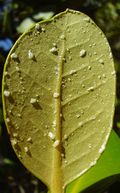 Salt crystals on a mangrove leaf [11] |
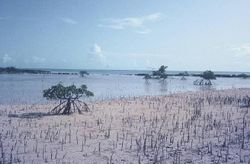 Extended root mass. Photo credit Eric Coppejans [12]. |
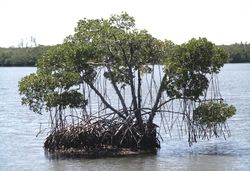 Drop roots from branches [13] |
Deposits of fine grained (muddy and sandy) sediments lack oxygen (Hogarth, 1999[8]).
Mangroves therefore have to cope with anoxic conditions. The tissue of the plants requires oxygen for respiration which cannot diffuse sufficiently into soils that are waterlogged. Even if the surface water is saturated with oxygen, its concentration in the groundwater is too low. This is why mangroves develop various forms of aerial roots.
- Most of the roots branch off from the stem underground. One type of roots is the prop root (also called stilt root). This root diverges from the tree and anchors into the bottom to stabilize the tree in the soft, muddy substrate. The rhizophore has lenticels on the upper surface, large pores with a corky layer enabling the uptake of oxygen. Seawater cannot get into the lenticels. The tissue of the prop roots consists of aerenchyma and is connected with the lenticels. Through this aerenchyma, oxygen can be provided to the submerged parts of the tree. The roots that break at alternating places through the soil surface and submerge again form a knee root.
 Knee roots. Photo credit Eric Coppejans [12] |
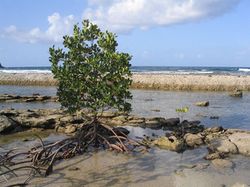 Prop roots growing from the lower trunk [11] |
- Another type of roots is a shallow, horizontal root that radiates outwards. The vertical root is called a pneumatophore and can be as high as several decimeters. These roots also have lenticels and aerenchyma. They can create a huge network of vertical roots. The horizontal root is called the cable root.
- The buttress root (also called plank root) is a root that covers the whole space between the upper part of the root and the bottom.
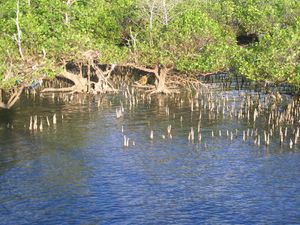 Pneumatophores on cable roots [11]. |
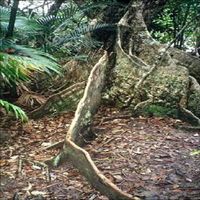 Buttress root (plank root). Photo credit Eric Coppejans [12]. |
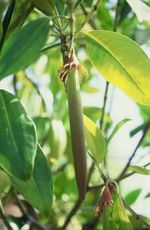 Propagules. Photo credit Eric Coppejans [12]. |
Observations of the mangrove species distribution along the Mekong delta coast showed that pneumatophore species (e.g., Avicennia alba) were preferentially found in accreting sites where soil was often inundated and oxygen-poor mud had accumulated. Stilt root species (e.g., Rhizophora apiculata) occurred mostly in erosion sites where stabilizing support is important. Knee root species (e.g., Bruguiera parviflora) dominated in higher sites with more stable substrate[14]. Avicennia marina, Rhizophora apiculata, Bruguiera gymnorrhiza and Xylocarpus granatum are species with high carbon sequestration capacity. A. marina and R. apiculata strive on sand-silt soils in the low-medium intertidal zone, while B. gymnorrhiza and X. granatum are often found on silt-clay soils in the high-intertidal zone, especially in estuaries[15].
Mangroves aid soil formation by trapping debris. Plank roots and pneumatophores accumulate sediments in protected sites and form mangrove peats; sediment trapping is a function of the volume of aboveground roots (Du et al., 2021[16]). Root production also contributes to soil elevation, even more than leaf, twig and branch litter, due to slow decomposition (Krauss et al., 2014[17]). Filamentous algae help to stabilize the fine sediments trapped by mangroves. They usually form a green-to-red mass over the substrate. They are also a filtering system for the land run-off and remove the terrestrial organic matter. They are very important habitats for many species of small fish, invertebrates and various epiflora and epifauna as well as larger birds. This is called a nursery function. The mangrove is a major producer of detritus that will contribute to offshore productivity in some seasons (Coppejans [18]).
Pollination of the trees is done by the wind or by organisms. All mangroves disperse their offspring by water. They produce unusually large propagating structures or propagules. The embryo initiates germination on the seed, still attached on the tree and further develops into a propagule. This phenomenon is known as vivipary.
Biota
Epiphytic micro-algae grow on the aerial roots of the trees and on the sediments. The algae are green ( Chlorophyta), brown (Phaeophyceae), red (Rhodophyta) and blue-green (Cyanophyta). The dense biomass on the aerial roots causes the water to remain on the pneumatophores; the lenticels are no longer functional and oxygen cannot penetrate into the roots. For this reason, the bark regularly falls off the root. This process is called decertification. Vertical zonation along a single pneumatophore occurs, but there is also a zonation from the upper limit of the mangroves to the lower limit.
Several invertebrate species are found in the mangrove ecosystem. Macrobenthic species are commonly or occasionally present because they are migrating or because they are living in adjacent environments. Crabs are keystone species in the mangrove ecosystem. This means that the presence of this animal in the community makes it possible for many other species to live there. The crabs go through their larval stages in the water beneath the mangroves. When they are mature, they crawl up on the mangroves and feed on the leaves. They can reach high densities and are crucial in the processing of leaf litter. Their burrowing activity modifies the micro-topography of the bottom and aerates the soil. This decreases the sulphide levels in the soil and positively influences the productivity of the trees. An example of a mangrove crab is the fiddler crab Uca lacteal.
An important bivalve is the purple oyster Lopha frons. This species encrusts the pneumatophores and prop roots. When the tide is high, barnacles and mussels compete with the oyster for space on the roots. Periwinkles also occur on the roots and stems, as well as on the shells of sedentary organisms attached on them. Snails are important in the turnover of the organic material. Other species that occur in the mangroves are tunicates, sponges, ants, hermit crabs, shrimps, fishes,… They are a source of nutrition for higher level predators. Species that cannot tolerate changing saline conditions can survive in the forest. These species are sea stars, brittle stars and sea squirts. Predators are clapper rails, diamondback turtles, water moccasins, raccoons and killifishes. Bacteria and fungi initially break down the leaf litter (decomposition). In the tree canopy, vertebrate fauna and birds are common. Examples of birds are pelicans, wood ibises, herons, egrets and roseate spoonbills (Hogarth, 1999 [8]).
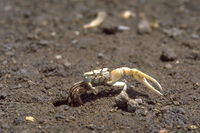 Fiddler crab Uca lacteal [19]. |
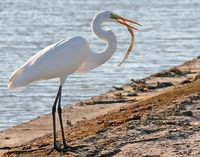 Egret Egretta alba [20]. |
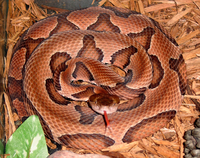 Water moccasin Agkistrodon contortrix [21]. |
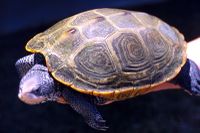 Diamondback turtle Malaclemys terrapin [22]. |
Coastal protection
Coastal protection is an important ecosystem service provided by mangroves. It has been estimated that mangroves protect millions of people from flooding every year, notably in densely populated areas of southeast Asia and reduce the costs of flood damages worldwide (Worthington and Spalding, 2018[23]). The global flood protection benefits of mangroves has been estimated at more than $US 65 billion per year[24].
Mangrove forests efficiently dissipate the energy of incident waves. Wave height reduction of 0.2 – 1.2 m has been observed per 100 m forest width, depending in particular on vegetation density (approximately linear dependence[25]) and vegetation type[3]. Even a narrow fringe of Rhizophora mangroves substantially reduces wave impulse forces on shoreward dikes or seawalls[26]. Mangroves help to mitigate the threat of inundation and devastation by storm surges and cyclones, building a living seawall that can slow or halt erosion, and temper flood flows driven by storm surges. Storm surge attenuation depends on the width and density of the mangrove belt, with a stronger effect of short trees compared to tall trees; an order of magnitude estimate of the observed decrease of storm surge height in the South Florida mangrove zone for Hurricane Wilma (2005) was 0.2 m per km forest width (Chen et al., 2021[27]). See also Wave damping by vegetation.
The coastal protection function is further enhanced by sediment trapping in mangrove forests. Observed annual accretion rates from external sources are of the order of one up to a few cm[28]. Moreover, thick litter layers build up over time due to accumulation of decaying organic matter, such as leaf and root litter and the formation of agal mats. However, in spite of substantial mineral and organic accretion, the observed net surface elevation change is much smaller - of the order of one or a few mm annually, generally positive and sometimes negative - due to subsidence and compaction processes[29].
Other ecosystem services
- Carbon sequestration (see Blue carbon sequestration). Deposition of plant litter and woody debris, root accumulation and algal mat development contribute to carbon storage. Belowground biomass represents 85% of the total biomass in many mangrove forests (Kauffman et al., 2020[30]). Alongi (2020[31]) estimated the carbon burial by mangroves at about 180 gC/m/year, yielding a global carbon sequestration of 10-15 million tonnes C /year. This is of the order of 1% of the global carbon sequestration by forests. However, according to Wang et al. (2021[32]), this figure is possibly underestimated by a factor 2-3 because the burial rate in the tropics is much faster than average (i.e. of the order of 400 gC/m/year). Carbon sequestration by mangroves may even be substantially larger than this burial estimate when taking into account the outwelling of dissolved inorganic carbon (DIC) to the deep sea.
- Food production. Mangrove communities are recognized as highly productive ecosystems that provide large quantities of organic matter to adjacent coastal waters in the form of detritus and live animals (fish, shellfish). The detritus serves as a nutrient source and is the base of an extensive food web in which organisms of commercial importance take part. In addition, mangrove ecosystems serve as shelter, feeding, and breeding zones for crustaceans, mollusks, fish of commercial importance, and resident and migratory birds (Holguin et al., 2001[33]).
- Denitrification. Anaerobic denitrification and nitrogen-fixation by certain bacteria and cyanobacteria associated with mangrove mud and with above-ground root systems can improve water quality from wastewater inputs (Romanacha et al., 2018[34]).
Threats
Mangroves are threatened in their existence by several causes, generally related to human activities.
- Reduction in river and surface run-off, that deprives tropical coastal deltas of fresh water and sediment. This results in coastal erosion, with loss of mangroves, reduced species diversity and less organic production. Both the terrestrial and aquatic food webs are altered and habitats for species of higher trophic levels are lost.
- The removal of sediment from around the roots by burrowing fiddler crabs leads to mangrove uprooting, tree collapse and increased wave impact[35].
- Soil reclamation for agriculture and aquaculture reduces regional biodiversity due to loss of mangrove habitats. Many mangrove forests worldwide have been cleared to make way for shrimp aquaculture, with a strong negative impact on biodiversity and coastal safety (increased erosion).
- Replacement of mangrove forest with dikes creates ponds with anoxic water that increases the level of sulphide in the soil and increases the pH leading to major shrimp losses.
- Within mangrove soils, microbial processes—including denitrification, ammonification dissimilatory nitrate reduction to ammonium, (DNRA), and anaerobic ammonium oxidation (anammox)—form a complex microbial N (nitrogen) transformation cycle (see Nutrient conversion in the marine environment). Nutrient enrichment (mainly from agricultural and urban effluents) stimulates growth of above-ground biomass and the ability of mangroves to act as nutrient sinks, due to high rates of nutrient uptake and denitrification. However, negative impacts have also been reported. Several studies have found that nutrient enrichment, specifically N, leads to a reduction in overall soil microbial biodiversity and organic matter (OM) composition in mangrove ecosystems. Not only could this alteration in OM composition result in lower sedimentary carbon, but could also decrease the potential for long-term carbon storage of root-derived OM while increasing carbon loss via soil respiration (Mack et al., 2024[36]). See also Possible consequences of eutrophication.
- A further issue is the clearcutting of mangals for their hard wood. This wood is resistant against termites and therefore an important export product for building constructions in areas with large concentrations of termites. The wood can also be used for charcoal and fuelwood. The substrate will be no longer stable when the trees are cut away and erosion will result (Besset et al., 2019[37]).
- A similar effect as with the added fertilizers and pesticides is the use of mangroves for waste-water treatment. Nutrients are added to the water and the equilibrium in the food web is disturbed. Mangroves no longer can survive in this environment and die off. The organic matter, normally stored in the mangroves, will be transported to open water and increases the aquatic primary production. This results in a huge amount of phytoplankton and water turbidity. Corals and seagrasses are strongly affected by these processes and will be deteriorated.
- Other coastal development activities influence on the quality of the water. Industry, tourism and port development involve land reclamation and dredging. This causes resuspension of the sediment and increases the water turbidity. Light penetration in the water will be limited causing damage to the mangroves.
- Spills of oil, toxic chemicals and dumping of waste into the water causes localized impacts on the mangroves. The introduction of alien species by ballast water or from the hulls of vessels will also have negative effects on the mangrove habitats. These species will compete with indigenous species for space and food.
- Climate change. Because mangroves raise the soil level, it is believed that mangrove forests can keep pace with a moderate sea level rise up till about 6 mm/year (Alongi, 2022[38]). Elevation gain by physical and biological processes generally exceeds subsoil compaction by dewatering and organic matter decomposition. In some cases, net elevation rates of about 5 mm/year have been recorded (Krauss et al., 2014[17]). Survival of mangroves therefore depends on the rate of reduction of current greenhouse gas emissions. Another threat is the impact of storms that may become more severe and more frequent so that periods available for recovery will become shorter. More frequent and heavier rainfall in tropical and subtropical regions can lead to more productive and luxuriant mangrove forests, but longer periods of extreme drought can cause significant damage to mangrove forests in arid areas. Inland migration of mangroves in response to sea-level rise may occur where the landward margin of mangroves is unimpeded by artificial or natural barriers (Friess et al., 2019[39]; Bozi et al., 2021[40]). In some cases, warm temperatures and sea level rise may drive latitudinal expansion of mangroves into existing salt marsh habitat in subtropical and tropical areas, resulting in greater soil carbon concentrations and blue carbon accumulation in the newly colonized mangroves (Kelleway et al., 2016[41]). It is further likely that with small temperature increases, mangroves will produce more carbon via higher primary production, but rates of leaf photosynthesis decline as temperatures increase from 33 to 35°C.
Mangrove loss
Worldwide, a total area of almost 10,000 km2 (about 7%) of mangrove has been lost between 1996 and 2016, while an estimated 1,400 km2 of remaining mangrove forests are identified as degraded (Worthington and Spalding, 2018[23]). Mangrove losses continue on every continent, although rates of loss have declined considerably from 1 – 3% in the late 20th century to 0.3 – 0.6% in the early 21st century (Friess et al., 2019[39]). The main causes of mangrove loss are transformation of forests into economic land use such as aquaculture and agriculture, wood production, and (urban) infrastructure. There is little chance of spontaneous mangrove regeneration in the deforested lands (Coppejans[18]; UNEP, 2006[42]), due to increased wave agitation and soil erosion (Winterwerp et al. 2013[43]). Non-native plant invasions may also restrict the re-growth of mangroves (Romanacha et al. 2018[34]).
Community participation in mangrove management
There is ample evidence that mangrove forests are better managed with the involvement and active participation of local communities[44]. Local indigenous communities have long been the guardians of the maritime and coastal environments in many parts of the world. These communities have utilized the resources in these regions responsibly based on ecological knowledge and cultural traditions developed as a result of historical and ongoing contact with the resources on which they rely[45].
Mangroves are a natural resource that can provide coastal communities with essential livelihoods. Government policies aimed at conserving mangrove forests by denying access to this resource are often doomed to failure. Given the right regulatory context, local communities are often best placed to develop and implement management practices appropriate to the ecosystem resource and social situation[44]. Uncontrolled exploitation of mangroves can lead to the loss of the natural resource due to the so-called 'tragedy of the commons'. Controlled exploitation, cutting down less healthy trees ('thinning') or the oldest trees ('selective harvesting') can even benefit the mangrove forest if young seedlings are planted in the cleared areas. Studies have reported enhanced stand biomass, improved growth conditions, increased carbon sequestration and improved forest productivity[46]. Controlled exploitation, based on enforced rules, can commit local communities to participate in sustainable mangrove management. Not all mangrove coasts can be managed in this way; stable or accreting coastlines are a requirement[47].
Mangrove restoration and rehabilitation
Causes of failure
Mangrove replanting projects have been undertaken in many places worldwide (Friess et al., 2019[39]). However, few replanting programs have proven successful. A first major issue is that many rehabilitation projects start planting before studying the original cause of mangrove loss to find out why there is no natural regeneration on site (Lewis, 2005[48]). Often essential conditions are not met because previous reclamations and interventions may have rendered the site less suitable for mangrove regeneration. For example, compacted mudflats often have permanently saturated soil with poor drainage, leading to anoxic and potentially acidic soil (Holguin et al., 2001[33]). A second major issue is that species chosen for replanting may not be appropriate for the currently prevailing site conditions. Site conditions include: salinity, soil type, soil anoxia, sulphate levels, nutrient levels, pH, wave energy, temperature, light levels, inundation regimes, tides and wind distribution of propagules and seeds (Wodehouse, 2019[49]). Other reported reasons for failure include: poor planting method, lack of aftercare (e.g. weeding) and monitoring, fresh water availability, lack of drainage and sediment availability and high wave energy (i.e. inappropriate site choice). Unfavorable biological conditions range from limited seed availability, insufficient seed transport capacity, to adverse biotic activity such as barnacle infestation, predation by crabs and bioturbation by worms, burying small seedlings. A further impediment is the large quantity of household waste, most notably plastic. Plastic getting stuck to seedlings increase the chance of uprooting, and covering pneumatophores causes deformation of the roots, while the tree attempts to outgrow the suffocating material (Winterwerp et al., 2020[50]).
Principles of Ecological Mangrove Restoration (EMR)
EMR aims at restoring the favorable habitat conditions for mangroves, and generally no planting is done (Lewis, 2005[48]). In this way, EMR strives for natural zonation and optimized species site matching. This results in fast growth of the forest and high survival rates. If abiotic conditions are favorable, mangroves generally recruit spontaneously and grow naturally. This is often preferable to planting, as natural recolonization can be very fast if conditions are favorable, whereas up to 85% of planting efforts fail. After restoration, it may take only 5 years to obtain a forest's maximum coastal protection capacity. Additionally, such capacity appears to be maintained throughout the forest's lifetime with minor variations, provided the forest is not affected by any conditions altering its health, such as extreme wave events or anthropogenic action that may modify its habitat (Maza et al., 2021[51]).
If regeneration through natural recruitment is not an option, species must be carefully selected for planting. Planting mixed species produces a richer mangrove community and higher plant success rates, provided it is accompanied by biotic and abiotic research, while often also requiring hydrological restoration (Primavera et al., 2012[52]).
Sites that have been altered by previous reclamation and interventions require prior physical restoration. Altered physical conditions include: wave climate, currents, flushing, sedimentation, and drainage. Wave conditions can be restored by the installation of permeable dams, consisting of horizontally placed brushwood, which damp the waves, and vertical poles to hold the brushwood. Bamboo is a suitable material for the construction of such dams. Detailed instructions for the construction of impermeable dams are given by Winterwerp et al. (2020[50]). The configuration of the dams must be designed such that the original sedimentation regime is also restored, as mangrove degradation may cause accreting/stable coastlines turning towards an erosive state (Besset et al., 2019[37]). Disturbance of the fine sediment balance is a also an important cause of the poor success of rehabilitation efforts on eroding coastlines (Winterwerp et al., 2020[50]). Newly formed mud flats should be protected from fishing and other bottom-disturbing activities, as frequent stirring up the fresh deposits will prevent mangrove recruitment. Project outcomes can further be improved by restoring appropriate hydrological connectivity with good tidal flushing and drainage (Lewis, 2005[48]).
An alternative method may exist to create conditions that stimulate mangrove regeneration in areas where coarse sediment (e.g. shell sand) is available. If the seabed in the vicinity contains such sediments, it can be winnowed for the stabilization or supply of possibly existing chenier remnants or otherwise for the construction of artificial cheniers some distance seaward of the shoreline. The protection provided by cheniers appears generally very beneficial for the development of mangrove forests, especially on microtidal coasts[53], see the article Chenier.
Rehabilitation of mangroves and their habitat is rarely successful without the involvement of local stakeholders. Socio-economic aspects should be included in restoration projects so that local communities benefit from sustainable mangrove use. It is essential to introduce sustainable economic activities alongside mangrove restoration, such as sustainable aquaculture and integrated mangrove-aquaculture schemes, fisheries, eco-tourism and non-timber forest products (Primavera et al., 2012[52]).
Cost-benefit of mangrove restoration
Estimates of costs and benefits of mangrove restoration widely diverge[54]. High-rated benefits are fisheries, timber, waste water treatment and coastal protection. An average estimate is 20,000 US$ per ha and per year, within a range of 500-100,000 US$. This large range can (partly) be explained by differences in valuation methods and site-specific factors such as vegetation characteristics (e.g. species, age, tree density, height, root), sediments (e.g. depth, nutrients) and various environmental variables (e.g. location, salinity, debris). Restoration costs reported in the literature fall in an even wider range of US$ 500-400,000 per ha, which can be (partly) explained by the type of engineering interventions, planting vs. natural regeneration and labour costs. Comparing the figures for restoration (per ha) and for benefits (per ha and per year), in almost every case efficient restoration measures yield benefits that greatly exceed the costs[54].
Further reading
Spalding, M. 2011. World Atlas of Mangroves: Mark Spalding, Mami Kainuma and Lorna Collins (eds.) London, Washington D.C.: Earthscan 2010. ISBN 978-1-84407-657-4
Related articles
- Marine habitats and ecosystems
- Blue carbon sequestration
- Characteristics of sedimentary shores
- Potential Impacts of Sea Level Rise on Mangroves
- Wave damping by vegetation.
- Chenier
- Coastal mud belt
External links
- UN Mangrove Management
- http://www.ozcoasts.gov.au/indicators/mangrove_areas.jsp
- http://www.vliz.be/vmdcdata/mangroves/index.php
- http://www.glomis.com
- https://en.wikipedia.org/wiki/Mangrove
References
- ↑ 1.0 1.1 http://www.vliz.be/vmdcdata/mangroves
- ↑ 2.0 2.1 Karleskint G. 1998. Introduction to marine biology. Harcourt Brace College Publishers. p.378
- ↑ 3.0 3.1 Horstman, E.M., Dohmen-Janssen, C.M., Narra, P.M.F., van den Berg, N.J.F., Siemerink, M. and Hulscher, S.J.M.H. 2014. Wave attenuation in mangroves: A quantitative approach to field observations. Coastal Engineering 94: 47–62
- ↑ Bunting, P., Rosenqvist, A., Hilarides, L., Lucas, R.M., Thomas, T., Tadono, T., Worthington, T.A., Spalding, M., Murray, N.J. and Rebelo, L-M. 2022. Global Mangrove Extent Change 1996 – 2020: Global Mangrove Watch Version 3.0. Remote Sensing. https://zenodo.org/records/6894273
- ↑ Jia, M., Wang, Z., Mao, D., Ren, C., Song, K., Zhao, C., Wang, C., Xiao, X. and Wang, Y. 2023. Mapping global distribution of mangrove forests at 10-m resolution. Science Bulletin 68: 1306–1316
- ↑ Bertness M.D., Gaines, S.D. and Hay, M.E. 2001. Marine Community Ecology. Sinauer Associates, Inc. p. 550
- ↑ Pinet P.R. 1998.Invitation to Oceanography. Jones and Barlett Publishers. p. 508
- ↑ 8.0 8.1 8.2 Hogarth P.J. 1999. The biology of mangroves. Oxford University Press. p.228
- ↑ Saintilan, N., Wilson, N., Rogers, K., Rajkaran, A. and Krauss, K.W. 2014. Mangrove expansion and saltmarsh decline at mangrove poleward limits. Glob. Change Biol. 20: 147–57
- ↑ Parida, A. K. and Jha, B. 2010. Salt tolerance mechanisms in mangroves: A review. Trees 24: 199–217
- ↑ 11.0 11.1 11.2 http://en.wikipedia.org/wiki/Mangrove
- ↑ 12.0 12.1 12.2 12.3 Eric Coppejans - http://www.vliz.be/imis/imis.php?module=person&persid=134
- ↑ http://sofia.usgs.gov/virtual_tour/ecosystems/index.html
- ↑ Nguyen, L.T.M., Hoang, H.T., Choi, E. and Park, P.S. 2023. Distribution of mangroves with different aerial root morphologies at accretion and erosion sites in Ca Mau Province, Vietnam. Estuarine, Coastal and Shelf Science 287, 108324
- ↑ Syahid, L.N., Sakti, A.D., Ward, R., Rosleine, D., Windupranata, W. and Wikantika, K. 2023. Optimizing the spatial distribution of Southeast Asia mangrove restoration based on zonation, species and carbon projection schemes. Estuarine, Coastal and Shelf Science 293, 108477
- ↑ Du, Q., Qin,Z., Ming, S. and Zhang, C. 2021 Differences in the vertical accretion of sediment among mangrove species with different aerial root types. Estuarine, Coastal and Shelf Science 256, 107375
- ↑ 17.0 17.1 Krauss, K.W., McKee, K.L., Lovelock, C.E., Cahoon, D.R., Saintilan, N., Reef, R. and Chen, L. 2014. How mangrove forests adjust to rising sea level. New Phytologist 202: 19–34
- ↑ 18.0 18.1 Eric Coppejans – Course Biodiversity of aquatic food webs: from algae to marine mammals UGent
- ↑ http://www.fiddlercrab.info/u_lactea.html
- ↑ http://en.wikipedia.org/wiki/Snowy_Egret
- ↑ http://en.wikipedia.org/wiki/Agkistrodon_contortrix
- ↑ http://en.wikipedia.org/wiki/Diamondback_turtle
- ↑ 23.0 23.1 Worthington, T. and Spalding, M. 2018. Mangrove Restoration Potential: A global map highlighting a critical opportunity. Report, 26 October 2018. doi:10.17863/CAM.39153
- ↑ Menendez, P., Losada, I.J., Torres-Ortega, S., Narayan, S. and Beck, M.W. 2020. The global flood protection benefits of mangroves. Sci. Rep. 10, 4404
- ↑ Kelty, K., Tomiczek, T., Cox, D.T., Lomonaco, P. and Mitchell, W. 2022. Prototype-Scale Physical Model of Wave Attenuation Through a Mangrove Forest of Moderate Cross-Shore Thickness: LiDAR-Based Characterization and Reynolds Scaling for Engineering With Nature. Front. Mar. Sci. 8: 780946
- ↑ Tomiczek, T., Mitchell, W.T., Lomonaco, P., Cox, D.T. and Kelty, K. 2024. Prototype-scale laboratory observations of wave force reduction by an idealized mangrove forest of moderate cross-shore width. Ocean Engineering 310, 118740
- ↑ Chen, Q., Li, Y., Kelly, D.M., Zhang, K., Zachry, B. and Rhome, J. 2021. Improved modeling of the role of mangroves in storm surge attenuation. Estuarine, Coastal and Shelf Science 260, 107515
- ↑ Chaudhuri, P., Chaudhuri, S. and Ghosh, R. 2019. The Role of Mangroves in Coastal and Estuarine Sedimentary Accretion in Southeast Asia. Sedimentary Processes - Examples from Asia, Turkey and Nigeria. IntechOpen DOI: http://dx.doi.org/10.5772/intechopen.85591
- ↑ Krauss, K.W., Cahoon, D.R., Allen, J.A., Ewel, K.C., Lynch, J.C. and Cormier, N. 2010. Surface elevation change and susceptibility of different mangrove zones to sea-level rise on Pacific high islands of Micronesia Ecosystems 13: 129–143
- ↑ Kauffman, J.B., Adame, M.F., Arifanti, V.B., Schile-Beers, L.M., Bernardino, A.F.,Bhomia, R.K., Donato, D.C., Feller, I.C., Ferreira, T.O., Jesus Garcia, M.d.C., MacKenzie, R.A., Megonigal, J.P., Murdiyarso, D., Simpson, L. and Hernandez Trejo, H. 2020. Total ecosystem carbon stocks of mangroves across broad global environmental and physical gradients. Ecol. Monogr. 90, e01405
- ↑ Alongi, D.M. 2020. Global significance of mangrove blue carbon in climate change mitigation. Science 2020, 2, 57
- ↑ Wang, F., Sanders, C.J., Santos, I.R., Tang, J., Schurech, M., Kirwan, M.L., Kopp, R.E., Zhu, K., Li, X., Yuan, J., Liu, W. and Li, Z. 2021. Global blue carbon accumulation in tidal wetlands increases with climate change. National Science Review 8: nwaa296
- ↑ 33.0 33.1 Holguin, G., Vazquez, P. and Bashan, Y. 2001. The role of sediment microorganisms in the productivity, conservation, and rehabilitation of mangrove ecosystems: an overview. Biol. Fertil. Soils 33: 265–278
- ↑ 34.0 34.1 Romanacha, S.S., DeAngelis, D.L., Koh, H.L., Li, Y., Teh, S.Y., Barizan, R.S.R. and Zhai, L. 2018. Conservation and restoration of mangroves: Global status, perspectives, and prognosis. Ocean and Coastal Management 154: 72–82
- ↑ Phong, N.T. 2024. Erosion of mangrove dominated muddy coasts in Vietnam and Indonesia: Processes and accelerating factors. Regional Studies in Marine Science 79, 103821
- ↑ Mack, M.R., Adam Langley, J., Feller, I.C. and Chapman, S.K. 2024 The ecological consequences of nutrient enrichment in mangroves. Estuarine, Coastal and Shelf Science 300, 108690
- ↑ 37.0 37.1 Besset, M., Gratiot, N., Anthony, E.J., Bouchette, F., Goichot, M. and Marchesiello, P. 2019. Mangroves and shoreline erosion in the Mekong River delta. Estuarine. Coastal Shelf Sci. 226, 106263
- ↑ Alongi, D.M. 2022. Impacts of Climate Change on Blue Carbon Stocks and Fluxes in Mangrove Forests. Forests 13, 149
- ↑ 39.0 39.1 39.2 Friess, D.A., Rogers, K., Lovelock, C.E., Krauss, K.W., Hamilton, S.E., Lee, S.Y., Lucas, R., Primavera, J., Rajkaran, A. and Shi, S. 2019. The state of the world’s mangrove forests: past, present and future. Annu. Rev. Environ. Resour. 44: 89–115
- ↑ Bozi, B.S., Figueiredo, B.L., Rodrigues, E., Cohen, M.C.L., Pessenda, L.C.R., Alves, E.E.N., de Souza, A.V., Bendassolli, J.A., Macario, K., Azevedo, P. and Culligan, N. 2021. Impacts of sea-level changes on mangroves from southeastern Brazil during the Holocene and Anthropocene using a multi-proxy approach. Geomorphology 390, 107860
- ↑ Kelleway, J.J., Saintilan, N., Macreadie, P.I., Skilbeck, C.G., Zawadzki, A. and Ralph, P.J. 2016. Seventy years of continuous encroachment substantially increase ‘blue carbon’ capacity as mangroves replace salt marshes. Glob. Change Biol. 22: 1097–1109
- ↑ UNEP. 2006. In the frontline: shoreline protection and other ecosystem services from mangroves and coral reefs. p.36
- ↑ Winterwerp, J., Erftemeijer, P., Suryadiputra, N., Van Eijk, P. and Zhang, L. 2013. Defining eco-morphodynamic requirements for rehabilitating eroding mangrove-mud coasts. Wetlands 33: 515–526
- ↑ 44.0 44.1 Rotich, B., Mwangi, E. and Lawry, S. 2016. Where land meets the sea: a global review of the governance and tenure dimensions of coastal mangrove forests. Bogor, Indonesia: CIFOR; Washington, DC: USAID Tenure and Global Climate Change Program
- ↑ Vierros, M. 2017. Communities and blue carbon: the role of traditional management systems in providing benefits for carbon storage, biodiversity conservation and livelihoods. Clim. Chang. 140: 89–100
- ↑ Phong, N.T. and Nuong, C.T. 2023. Thinning, selective harvesting and mangrove protection forests: Lessons learned and recommendations from the Vietnamese Mekong Delta. Estuarine, Coastal and Shelf Science 288, 108345
- ↑ Luom, T.T., Phong, N.T., Smithers, S. and Tai, V.T. 2021. Protected mangrove forests and aquaculture development for livelihoods. Ocean and Coastal Management 205, 105553
- ↑ 48.0 48.1 48.2 Lewis III, R.R. 2005. Ecological engineering for successful management and restoration of mangrove forests. Ecol. Eng. 24: 403–418
- ↑ Wodehouse, D.C. and Rayment, M.B. 2019. Mangrove area and propagule number planting targets produce sub-optimal rehabilitation and afforestation outcomes. Estuar. Coast. Shelf Sci. 222: 91–102
- ↑ 50.0 50.1 50.2 Winterwerp, J.C., Albers, T., Anthony, E.J., Friess, D.A., Mancheno, A.G., Moseley, K., Muhari, A., Naipal, S., Noordermeer, J., Oost, A., Saengsupavanich, C., Tas, S.A.J., Tonneijck, F.H., Wilms, T., Van Bijsterveldt, C., Van Eijk, P., Van Lavieren, E. and Van Wesenbeeck, B.K. 2020. Managing erosion of mangrove-mud coasts with permeable dams – lessons learned. Ecological Engineering 158, 106078
- ↑ Maza, M., Lara, J.L. and Losada, I.J. 2021. Predicting the evolution of coastal protection service with mangrove forest age. Coastal Engineering 168, 103922
- ↑ 52.0 52.1 Primavera, J.H., Savaris, J.P., Bajoyo, B.E., Coching, J.D., Curnick, D.J., Golbeque, R.L., Guzman, A.T., Henderin, J.Q., Joven, R.V., Loma, R.A. and Koldewey, H.J. 2012. Manual on Community-based Mangrove Rehabilitation, Mangrove Manual Series No.1 London. 240 pp.
- ↑ van Bijsterveldt, C.E.J., van der Wal, D., Mancheno, A.G., Fivash, G.S., Helmi, M. and Bouma, T.J. 2023. Can cheniers protect mangroves along eroding coastlines? – The effect of contrasting foreshore types on mangrove stability. Ecological Engineering 187, 106863
- ↑ 54.0 54.1 Su, J., Friess, D.A. and Gasparatos, A. 2021. A meta-analysis of the ecological and economic outcomes of mangrove restoration. Nature Communications 12: 5050
Please note that others may also have edited the contents of this article.
|
